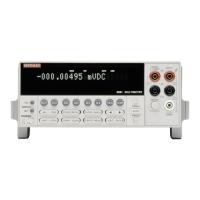IEEE-488 Reference
4-4
4.4 Controller programming
The programming instructions covered in this section use ex-
amples written with Hewlett-Packard BASIC version 4.0.
This language was chosen because of its versatility in con-
trolling the IEEE-488 bus. This section covers those state-
ments that are essential to Model 2001 operation.
NOTE
Controller programming information for
using the IBM PC interface through the
Capital Equipment Corporation (CEC),
I/O Tech, and National IEEE-488
interfaces is located in the Appendix.
A partial list of HP BASIC 4.0 statements is shown in Table
4-2. The statements have a one or three digit argument that
must be specified. The first digit is the interface select code,
which is set to 7 at the factory. The last two digits of those
statements requiring a 3-digit argument specify the primary
address.
Those statements with a 3-digit argument show a primary ad-
dress of 16 (the factory set primary address). For a different
address, you would, of course, change the last two digits to
the required value. For example, to send a GTL command to
a device using a primary address of 17, the following state-
ment would be used: LOCAL 717.
Some of the statements have two forms; the exact configura-
tion depends on the command to be sent over the bus. For ex-
ample, CLEAR 7 sends a DCL command, while CLEAR
716 sends the SDC command to a device with a primary ad-
dress of 16.
4.5 Front panel aspects of
IEEE-488 operation
The following paragraphs discuss aspects of the front panel
that are part of IEEE-488 operation, including messages, sta-
tus indicators, and the LOCAL key.
4.5.1 Error and status messages
Table 3-4 summarizes the error and status messages associ-
ated with IEEE-488 programming. Note that the instrument
may be programmed to generate an SRQ, and command que-
ries can be performed to check for specific error conditions.
4.5.2 IEEE-488 status indicators
The REM (remote), TALK (talk), LSTN (listen), and SRQ
(service request) annunciators show the present IEEE-488
status of the instrument. Each of these indicators is briefly
described below.
REM —
As the name implies, this indicator shows when the
instrument is in the remote state. Note that REM does not
necessarily indicate the state of the REN line, as the instru-
ment must be addressed to listen with REN true before the
REM indicator turns on. When the instrument is in remote,
all front panel keys except for the LOCAL key are locked
out. When REM is turned off, the instrument is in the local
state, and front panel operation is restored.
TALK —
This indicator is on when the instrument is in the
talker active state. The unit is placed in this state by address-
ing it to talk with the correct MTA (My Talk Address) com-
mand. TALK is off when the unit is in the talker idle state.
The instrument is placed in the talker idle state by sending it
an UNT (Untalk) command, addressing it to listen, or with
the IFC (Interface Clear) command.
LSTN —
This indicator is on when the Model 2001 is in the
listener active state, which is activated by addressing the in-
strument to listen with the correct MLA (My Listen Address)
command. Listen is off when the unit is in the listener idle
state. The unit can be placed in the listener idle state by send-
ing UNL (Unlisten), addressing it to talk, or by sending IFC
(Interface Clear) over the bus.
SRQ —
The instrument can be programmed to generate a
service request (SRQ) when one or more errors or conditions
occur. When this indicator is on, a service request has been
generated. This indicator will stay on until the serial poll byte
is read or all the conditions which caused SRQ have ceased
to exist. See paragraph 4.6.8 for details.
Table 4-2
HP BASIC 4.0 IEEE-488 statements
Action BASIC statement
Transmit string to device 16.
Obtain string from device 16.
Send GTL to device 16.
Send SDC to device 16.
Send DCL to all devices.
Send remote enable.
Cancel remote enable.
Serial poll device 16.
Send local lockout.
Send GET to device 16.
Send IFC.
OUTPUT 716;A$
ENTER 716;A$
LOCAL 716
CLEAR 716
CLEAR 7
REMOTE 7
LOCAL 7
SPOLL (716)
LOCAL LOCKOUT 7
TRIGGER 716
ABORT 7

